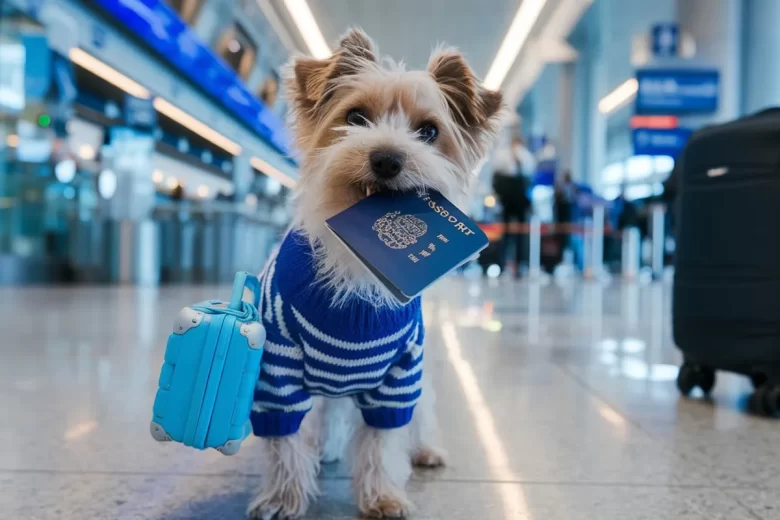Traveling with your dog involves careful planning and preparation to ensure their safety and well-being. One crucial aspect that often gets overlooked is proper pet identification. Having reliable identification for your dog can make a significant difference in case they get lost, whether you’re traveling locally or internationally. This guide will explore why pet identification is essential, the different methods available, and how to use them correctly to ensure your dog’s safety during travel.
Why Pet Identification Matters
Pet identification is more than just a precaution—it’s a vital safety measure. Here’s why it’s essential:
- Reuniting Lost Pets: If your dog goes missing, having proper identification increases the chances of a quick reunion. Identifying information helps others contact you immediately.
- Legal Requirements: In some regions, having identification for your pet is a legal requirement. Ensuring compliance helps you avoid fines and legal issues.
- Travel Compliance: Many countries and airlines require pets to have identification for entry. Proper identification ensures you meet travel regulations and avoid complications.
Types of Pet Identification
There are several methods of identifying your pet, each with its own benefits and uses. Combining multiple methods can offer the best protection.
1. ID Tags
ID tags are a traditional and effective form of identification. They are typically attached to your dog’s collar and include essential information.
- What to Include: Your dog’s ID tag should have your contact information, such as your phone number, and possibly your address. In some cases, you might also include a secondary contact person’s information.
- Tag Materials: ID tags come in various materials, including metal, plastic, and silicone. Choose a durable material that can withstand wear and tear.
2. Microchips
Microchipping is a permanent and reliable form of identification. It involves implanting a small chip under your dog’s skin, which contains a unique identification number.
- How It Works: A microchip is scanned using a special reader to retrieve the identification number, which is then used to access your contact details through a pet recovery database.
- Registration: After microchipping, it’s crucial to register your pet’s microchip with a pet recovery database and keep your contact information up-to-date.
3. GPS Trackers
GPS trackers provide real-time location tracking, which can be invaluable if your dog goes missing.
- Features: GPS trackers offer features such as live tracking, geofencing (alerts if your dog leaves a designated area), and even activity monitoring.
- Compatibility: Ensure the GPS tracker is compatible with your dog’s collar and that it has sufficient battery life for long trips.
4. Tattooing
Tattooing is another form of permanent identification, usually applied to a specific area of your dog’s body.
- What to Know: Tattoos can be less common due to the advent of microchipping and are usually done on the inner thigh or ear. They are less effective if your dog has a thick coat.
- Considerations: Ensure the tattoo is done by a professional to avoid complications or infection.
How to Use Pet Identification Correctly
Proper use of pet identification involves more than just having the tags and chips. Here’s how to ensure you’re using them effectively:
1. Keep Information Up-to-Date
Regularly update your contact information on ID tags, microchip databases, and GPS trackers.
- ID Tags: Check that the information on your dog’s ID tag is current before traveling. Replace tags if they become worn or unreadable.
- Microchips: Verify and update your details with the microchip registry, especially after moving or changing phone numbers.
2. Ensure Proper Fit
For physical identification methods like ID tags and collars, ensure they fit securely but comfortably.
- Collar Fit: The collar should be snug enough to prevent slipping but loose enough to avoid chafing. Regularly check the fit and adjust if necessary.
- Tag Attachment: Ensure the ID tag is securely attached to the collar to prevent it from falling off.
3. Combine Identification Methods
Using multiple forms of identification offers added security. Combine ID tags, microchips, and GPS trackers to maximize safety.
- Layered Protection: Having a tag and a microchip ensures that your pet can be identified whether found by a person who reads the tag or a vet who scans the chip.
- Travel Preparation: If traveling internationally, ensure all forms of identification are compliant with the destination country’s regulations.
Preparing for Travel with Your Pet
Traveling with your dog requires additional preparation to ensure their identification remains effective and secure. Here are some tips:
1. Pre-Travel Check
Before you travel, conduct a thorough check of your pet’s identification.
- Inspection: Examine ID tags for readability, ensure the microchip is functioning properly, and verify the GPS tracker is charged.
- Documentation: Carry documentation of your pet’s microchip number and contact information for easy reference if needed.
2. Emergency Plan
Have a plan in place in case your dog goes missing during your trip.
- Local Resources: Familiarize yourself with local animal shelters, vet clinics, and lost pet services in your travel area.
- Contact Information: Keep a list of local contacts and emergency numbers handy.
3. Travel-Specific Considerations
Different types of travel require different considerations for pet identification.
- Air Travel: Ensure your dog’s identification meets airline requirements. Some airlines may have specific guidelines for tags and microchips.
- International Travel: Research and comply with the pet identification requirements of the destination country.
Proper pet identification is a crucial aspect of traveling with your dog, ensuring their safety and increasing the likelihood of a quick reunion if they become lost. By understanding and utilizing various forms of identification—such as ID tags, microchips, GPS trackers, and tattoos—you can provide comprehensive protection for your furry friend.
Remember to keep all information up-to-date, ensure proper fit and use, and prepare thoroughly before and during your travels. With these measures in place, you can travel with confidence, knowing that your dog is well-identified and protected, no matter where your adventures take you.

I’m Philippe Perrenoud, a passionate adventurer with dogs and an advocate for experiences that strengthen the bond between humans and their four-legged companions. My mission is to share practical tips so you and your dog can explore the world safely and joyfully. Together, we can turn every journey into an unforgettable memory!




